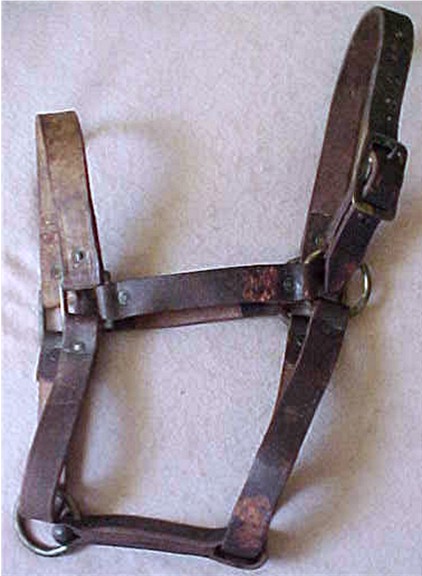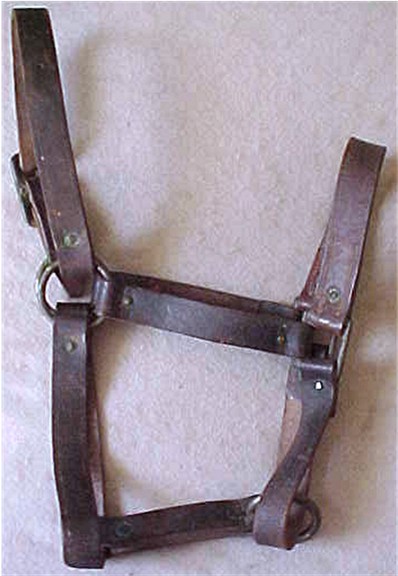|
US CAVALRY HALTERS – SCARCE SELECTION OF MODEL
1885, MODEL 1904 ENLISTED MAN’S AND MODEL 1904
OFFICER’S: The combination of years of hard
use, the minor differences in design, and the basic
utilitarian nature of these US Army Halters, very few
seem to have survived in contrast to other pieces of
horse equipment. Years after the cavalry gave up their
horses and were mechanized, the army still retained some
horses and a large number of mules, and these halters
continued to be issued and consumed, leaving relatively
few to pass into the collector’s market.
The simple Model 1859 Halter, limited in its capacity
for size adjustment with only one buckle, continued to
be the standard pattern after the Civil War, and is
described in the 1874 Cavalry Equipment Ordnance
Memoranda No. 18 with the first indications of a need
for a change in design, “To be of the same pattern and
dimensions as at present, with these modifications…” and
then details some very minor modifications of length of
the parts, and more significantly, the addition of a
buckle on the chin strap – that strap that passes around
the lower muzzle of the horse’s head.
With the adoption of the Model 1885 Equipment as
described in Ordnance Memoranda No. 29, a more complex,
and significant design for the halter was ordered. The
Model 1885 Halter, as described and pictured in the
manual, was made of black leather with buckles, rings,
square loops, swivel loops made of iron, and was
assembled with brass rivets as was the balance of the
Model 1885 Horse Equipment. The Model 1885 Halter
continued in service through the end of the Indian Wars,
the Spanish American War, and the conflicts around the
turn of the century, until replaced by the Model 1904
Equipment when distinct patterns of halters were adopted
for the officers and enlisted men.
The Model 1904 Enlisted Man’s Halter and the Model 1904
Officer’s Halter were of the same design as the Model
1885 Halter, but were made from russet leather,
following the change in leather color adopted in 1902.
The Model 1904 Enlisted Halter and Officer’s Halter were
distinguished from each other only in the metal fittings
– the Enlisted Halter was fitted with iron hardware and
assembled with iron tubular rivets, while the Officer’s
Halter was fitted with bronze hardware and assembled
with brass or copper rivets.
That these (and a very few other) specimens of one of
the most basic, and yet very necessary, pieces of US
Army horse equipment have survived is worthy of note in
and of itself. Halters were the type of equipment that
was very likely considered to be expendable when it was
issued given the nature of the intended use and the
environment in which it was used, and once in the hands
of the troops they were used to destruction. And, just
as significant, is to note that even though the patterns
changed through time, the previous patterns still on
hand in the company or regimental stables were most
likely continued in use, if not for regular garrison or
field duty, then most certainly for day to day movement
of horses to and from pasture and watering sites. With
this heavy use in mind, it is not surprising that those
that do survive show signs of repair, modification to
fit a specific horse, or have replaced straps, rather
this sort of age related wear is to be expected.
Often missing from
collections, these halters were one of the most
important and basic pieces of the cavalryman’s equipment
in order to maintain control of his mount. I
currently have the following halters in stock and each
one is described and priced individually below with
accompanying photographs.
|
|
No. 1 MODEL 1904 OFFICERS HALTER: A very
nice example, with the bronze metal fittings and full
length straps. For some reason, two of the three of
these officer’s halters - this being one of the two -
have had the buckle on the chin strap removed, obviously
deliberately done and both done in the same fashion. I
suspect that one particular group of officers, perhaps
all in the same regiment as all of these halters were
obtained in one lot, were of the opinion that the second
buckle was unnecessary or was prone to foul in the other
equipment. All of the other bronze fittings are intact,
and all of the straps are supple and solid, with some
very minor surface crazing in isolated spots. This early
20th Century officer’s halter is in very nice
condition and displays very well. (0205) $250
 
|

